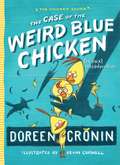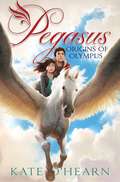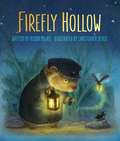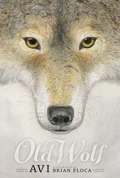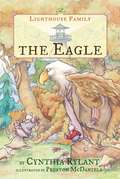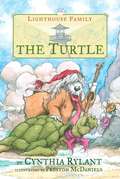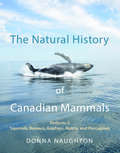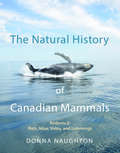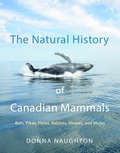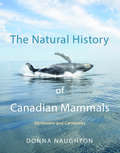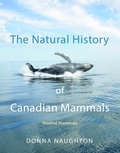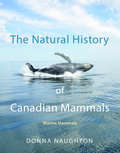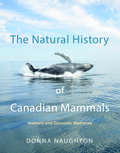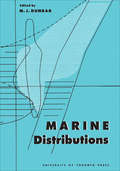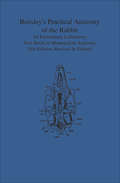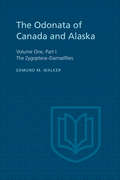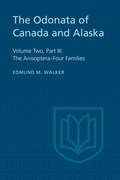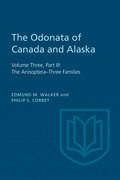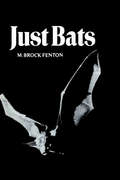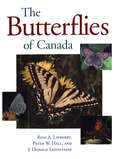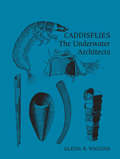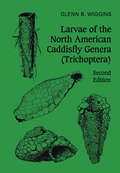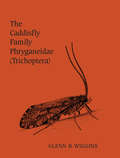- Table View
- List View
The Case of the Weird Blue Chicken: The Next Misadventure
by Doreen Cronin Kevin CornellThe Chicken Squad is back for their second (mis)adventure, and this time they're solving the mystery of a kidnapped...HOUSE? A hilarious, "easy to read" (Booklist) chapter book from the bestselling author of Click, Clack, Moo and The Trouble with Chickens.Dirt, Sugar, Sweetie, and Poppy are the four members of The Chicken Squad, and business is booming. A weird blue bird has just flown into Chicken Squad headquarters squawking on about a house-napper (yes, house-napper), and it is once again up to the squad to uncover who is up to no good. But there is something NUTS about this story that the squad can't quite put their feather on...and oh, brother, is it key to solving the case!
The Case of the Weird Blue Chicken
by Doreen Cronin Kevin CornellThe Chicken Squad is back for their second (mis)adventure, and this time they're solving the mystery of a kidnapped...HOUSE? A hilarious chapter book from the bestselling author of Click, Clack, Moo and The Trouble with Chickens.Dirt, Sugar, Sweetie, and Poppy are the four members of The Chicken Squad, and business is booming. A weird blue bird has just flown into Chicken Squad headquarters squawking on about a house-napper (yes, house-napper), and it is once again up to the squad to uncover who is up to no good. But there is something NUTS about this story that the squad can't quite put their feather on...and oh, brother, is it key to solving the case!
Origins of Olympus (Pegasus #4)
by Kate O'HearnEmily and her winged horse, Pegasus, face an ancient challenge of Olympic proportions in this fourth book of an exciting series.A deadly plague has struck Olympus. While the Olympians fade one by one, Emily's heart breaks as she watches, particularly when Pegasus begins to slip away. Determined to save him, she embarks on an investigation that takes her back in time to the origins of Olympus and to the deadly battle between the Olympians and the Titans. In the present, she must face the full force of the CRU. In the past, she must confront Cronus, the father of the gods and leader of the Titans, who is intent on destroying his offspring. When Emily encounters the full power of the flame and a discovery that could change the face of history, will she make the right decisions? And in the race against time to save Pegasus, will Olympus find its true hero?
Firefly Hollow
by Alison Mcghee Christopher DeniseFirefly. Cricket. Vole. Peter. Can four creatures from four very different Nations help one another find their ways in the world that can feel oh-so-big? Delve into this lush, unforgettable tale in the tradition of Charlotte's Web and The Rats of NIMH, from the author of the New York Times bestselling Someday.Firefly doesn't merely want to fly, she wants to touch the moon. Cricket doesn't merely want to sing about baseball, he wants to catch. When these two little creatures with big dreams wander out of Firefly Hollow, refusing to listen to their elders, they find themselves face-to-face with the one creature they were always told to stay away from...a giant.But Peter is a Miniature Giant. They've always been told that a Miniature Giant is nothing but a Future Giant, but this one just isn't quite as big or as scary as the other Giants. Peter has a dream of his own, as well as memories to escape. He is overwhelmed with sadness, and a summer with his new unlikely friends Firefly and Cricket might be just what he needs. Can these friends' dreams help them overcome the past?Firefly Hollow is nothing short of enchanting, reminding us all that the very best friend is the one who wants you to achieve your dreams. Full-color tip-in illustrations and dozens of black-and-white drawing provide added glow.
Old Wolf
by Avi Brian FlocaHunting--the predator, and its prey--is at the heart of this riveting and suspenseful novel from Newbery Medalist Avi with illustrations from Caldecott Medalist Brian Floca.In the computer game world of Bow Hunter--Casey's world--there are no deaths, just kills. In Nashoba's world--the wolf world--there have been no kills. For this is March, the Starving Time in the Iron Mountain region of Colorado, when wolves and ravens alike are desperate for food. With the help of a raven, the miraculous Merla, Nashoba must lead his pack of eight to a next meal. The wolf hates being dependent on a mere bird, but Merla is a bird wise beyond her years. And when thirteen-year-old Casey crosses their path, two very different approaches to hunting collide.
The Eagle (Lighthouse Family #3)
by Cynthia Rylant Preston McdanielsIn a lighthouse by the ocean, Seabold, a dog, and Pandora, a cat, live with their three little mice children, Whistler, Lila, and Tiny. One day, Lila and Whistler decide they want to investigate the mysterious forest that stands near their home. What adventures could be waiting between those trees? Brother and sister ask permission to go exploring and discover not only adventure and enchantment but also a new friend!
The Turtle
by Cynthia Rylant Preston McdanielsA thick fog has found its way up north to the lighthouse family, surrounding the cliffs and waters below. Always ready to lend a hand, the lighthouse siblings Whistler and Lila help Seabold guide small ships to land. As they overlook the foggy waters, they hear a distant voice echoing from the rocks below. Who could it be? Using only a rope and their hearts to guide them, Seabold, Lila, and Whistler make their way down the side of the cliff. And what they discover will help them weather even the thickest fog -- a new friend.
The Octopus
by Cynthia Rylant Preston McdanielsNewbery Medalist Cynthia Rylant brings the peaceful sounds, sights, and characters of the coast vividly to life in the fifth book of the Lighthouse Family series, in which the family explores the shore with an octopus friend.Every once in a while, a full moon shines over the lighthouse and causes the tide to recede. For Cloe the octopus, this turns out to be a wonderful opportunity to explore the world that exists outside of his ocean home. As he embarks on his expedition, he encounters the lighthouse family by the beach and they explore the treasures of the uncovered ocean floor together.
The Natural History of Canadian Mammals: Squirrels, Beavers, Gophers, Nutria, and Porcupines
by Donna NaughtonThis ebook is a subset of The Natural History of Canadian Mammals and includes the first section on rodents and features descriptions of squirrels, beavers, gophers, nutria, and porcupines.<P> The Natural History of Canadian Mammals is a beautifully illustrated, up-to-date guide to all 215 known species of mammals in Canada. It features brand-new, full-colour images of each species, as well as stunning photographs from Canadian Geographic magazine's national photography competitions depicting the animals in their natural environments. Along with being a visual treat, this book is jam-packed with information accessible to readers at all levels. Detailed descriptions are provided of each mammal's appearance, habitat, and behavior, while colour maps show their full distribution across Canada, North America, and globally. The book also includes practical guides on tracking and identification for readers who would like to learn how to spot mammals in the wild. Among its most special features is a series of colour plates with vignettes of the Canadian representatives of each group, sized relative to one another for easy comparison and linked to the full species accounts later in the book.<P> Advisory: Bookshare has learned that this book offers only partial accessibility. We have kept it in the collection because it is useful for some of our members. To explore further access options with us, please contact us through the Book Quality link on the right sidebar. Benetech is actively working on projects to improve accessibility issues such as these.
The Natural History of Canadian Mammals: Rats, Mice, Voles, and Lemmings
by Donna NaughtonThis ebook is a subset of The Natural History of Canadian Mammals, covering rodents and including the sections on Rats, Mice, Voles, and Lemmings. <P> The Natural History of Canadian Mammals is a beautifully illustrated, up-to-date guide to all 215 known species of mammals in Canada. It features brand-new, full-colour images of each species, as well as stunning photographs from Canadian Geographic magazine's national photography competitions depicting the animals in their natural environments. Along with being a visual treat, this book is jam-packed with information accessible to readers at all levels. Detailed descriptions are provided of each mammal's appearance, habitat, and behavior, while colour maps show their full distribution across Canada, North America, and globally. The book also includes practical guides on tracking and identification for readers who would like to learn how to spot mammals in the wild. Among its most special features is a series of colour plates with vignettes of the Canadian representatives of each group, sized relative to one another for easy comparison and linked to the full species accounts later in the book.<P> Advisory: Bookshare has learned that this book offers only partial accessibility. We have kept it in the collection because it is useful for some of our members. To explore further access options with us, please contact us through the Book Quality link on the right sidebar. Benetech is actively working on projects to improve accessibility issues such as these.
The Natural History of Canadian Mammals: Pikas, Hares, Rabbits, Shrews, Moles, and Bats
by Donna NaughtonThis ebook is a subset of The Natural History of Canadian Mammals, including the sections on Pikas, Hares, Rabbits, Shrews, Moles, and Bats.<P> The Natural History of Canadian Mammals is a beautifully illustrated, up-to-date guide to all 215 known species of mammals in Canada. It features brand-new, full-colour images of each species, as well as stunning photographs from Canadian Geographic magazine's national photography competitions depicting the animals in their natural environments. Along with being a visual treat, this book is jam-packed with information accessible to readers at all levels. Detailed descriptions are provided of each mammal's appearance, habitat, and behavior, while colour maps show their full distribution across Canada, North America, and globally. The book also includes practical guides on tracking and identification for readers who would like to learn how to spot mammals in the wild. Among its most special features is a series of colour plates with vignettes of the Canadian representatives of each group, sized relative to one another for easy comparison and linked to the full species accounts later in the book.<P> Advisory: Bookshare has learned that this book offers only partial accessibility. We have kept it in the collection because it is useful for some of our members. To explore further access options with us, please contact us through the Book Quality link on the right sidebar. Benetech is actively working on projects to improve accessibility issues such as these.
The Natural History of Canadian Mammals: Opossums, Wild Cats, Wild Dogs, Bears, Seals, Sea Lions, Walruses, Weasels, Skunks, and Raccoons
by Donna NaughtonThis ebook is a subset of The Natural History of Canadian Mammals, including the sections on Opossums, Wild Cats, Wild Dogs, Bears, Seals, Sea Lions, Walruses, Weasels, Skunks, and Raccoons.<P> The Natural History of Canadian Mammals is a beautifully illustrated, up-to-date guide to all 215 known species of mammals in Canada. It features brand-new, full-colour images of each species, as well as stunning photographs from Canadian Geographic magazine's national photography competitions depicting the animals in their natural environments. Along with being a visual treat, this book is jam-packed with information accessible to readers at all levels. Detailed descriptions are provided of each mammal's appearance, habitat, and behavior, while colour maps show their full distribution across Canada, North America, and globally. The book also includes practical guides on tracking and identification for readers who would like to learn how to spot mammals in the wild. Among its most special features is a series of colour plates with vignettes of the Canadian representatives of each group, sized relative to one another for easy comparison and linked to the full species accounts later in the book.<P> Advisory: Bookshare has learned that this book offers only partial accessibility. We have kept it in the collection because it is useful for some of our members. To explore further access options with us, please contact us through the Book Quality link on the right sidebar. Benetech is actively working on projects to improve accessibility issues such as these.
The Natural History of Canadian Mammals: Horses, Deer, Bison, etc.
by Donna NaughtonThis ebook is a subset of The Natural History of Canadian Mammals, including the sections on horses, deer, bison and animals in the same families.<P> The Natural History of Canadian Mammals is a beautifully illustrated, up-to-date guide to all 215 known species of mammals in Canada. It features brand-new, full-colour images of each species, as well as stunning photographs from Canadian Geographic magazine's national photography competitions depicting the animals in their natural environments. Along with being a visual treat, this book is jam-packed with information accessible to readers at all levels. Detailed descriptions are provided of each mammal's appearance, habitat, and behavior, while colour maps show their full distribution across Canada, North America, and globally. The book also includes practical guides on tracking and identification for readers who would like to learn how to spot mammals in the wild. Among its most special features is a series of colour plates with vignettes of the Canadian representatives of each group, sized relative to one another for easy comparison and linked to the full species accounts later in the book.<P> Advisory: Bookshare has learned that this book offers only partial accessibility. We have kept it in the collection because it is useful for some of our members. To explore further access options with us, please contact us through the Book Quality link on the right sidebar. Benetech is actively working on projects to improve accessibility issues such as these.
The Natural History of Canadian Mammals: Cetaceans
by Donna NaughtonThis ebook is a subset of The Natural History of Canadian Mammals, including the sections on whales, dolphins, and porpoises.<P> The Natural History of Canadian Mammals is a beautifully illustrated, up-to-date guide to all 215 known species of mammals in Canada. It features brand-new, full-colour images of each species, as well as stunning photographs from Canadian Geographic magazine's national photography competitions depicting the animals in their natural environments. Along with being a visual treat, this book is jam-packed with information accessible to readers at all levels. Detailed descriptions are provided of each mammal's appearance, habitat, and behavior, while colour maps show their full distribution across Canada, North America, and globally. The book also includes practical guides on tracking and identification for readers who would like to learn how to spot mammals in the wild. Among its most special features is a series of colour plates with vignettes of the Canadian representatives of each group, sized relative to one another for easy comparison and linked to the full species accounts later in the book.<P> Advisory: Bookshare has learned that this book offers only partial accessibility. We have kept it in the collection because it is useful for some of our members. To explore further access options with us, please contact us through the Book Quality link on the right sidebar. Benetech is actively working on projects to improve accessibility issues such as these.
The Natural History of Canadian Mammals: Domestic Animals
by Donna NaughtonThis ebook is a subset of The Natural History of Canadian Mammals, including the sections on domestic animals.<P> The Natural History of Canadian Mammals is a beautifully illustrated, up-to-date guide to all 215 known species of mammals in Canada. It features brand-new, full-colour images of each species, as well as stunning photographs from Canadian Geographic magazine's national photography competitions depicting the animals in their natural environments. Along with being a visual treat, this book is jam-packed with information accessible to readers at all levels. Detailed descriptions are provided of each mammal's appearance, habitat, and behavior, while colour maps show their full distribution across Canada, North America, and globally. The book also includes practical guides on tracking and identification for readers who would like to learn how to spot mammals in the wild. Among its most special features is a series of colour plates with vignettes of the Canadian representatives of each group, sized relative to one another for easy comparison and linked to the full species accounts later in the book.<P> Advisory: Bookshare has learned that this book offers only partial accessibility. We have kept it in the collection because it is useful for some of our members. To explore further access options with us, please contact us through the Book Quality link on the right sidebar. Benetech is actively working on projects to improve accessibility issues such as these.
Marine Distributions (The Royal Society of Canada Special Publications #5)
by Maxwell DunbarA symposium of the Royal Society of Canada was held in June 1962 to outline what is being done in Canadian oceanography to map salinity, temperature, and plankton in the waters around Canada and in the North Atlantic across to Europe. This volume, based on the symposium, emphasizes the interdisciplinary nature of research in marine biogeography and in the distribution of environmental factors in the sea. The book is intended to show the breadth of biogeographic work in the sea, and the relation between biogeography and the physics and chemistry of the marine environment. It serves also to introduce to the scientific public the new Serial Atlas of the Marine Environment, a scientific journal of a new kind of sponsored jointly by the Royal Society of Canada and the U.S. National Academy of Sciences.
Bensley's Practical Anatomy of the Rabbit: An Elementary Laboratory Text-Book in Mammalian Anatomy (Eighth Edition, Revised and Edited)
by E. Horne CraigieThe anatomical study of an animal is chiefly a matter of applying a certain practical method of exposition, the student's attention being concentrated on those facts which can be made out by direct observation. This method is educative in the technical sense because it involves accurate discernment of detail, and because, as a means of obtaining first-hand information, it is the foundation of laboratory practice. This being the case, it is a very pertinent question what is the best procedure. So far, as the present book is concerned, it is expected that the study of the type will begin with at least a preliminary survey of the prepared skeleton (Part II). This will be followed by dissection (Part III), in which the order by sections will be found of less importance than that of details in any particular region and and in which portions of the skeleton related to the part under examination may be included.The regional method of approach is indicated rather than the more complete study of single systems, partly for the sake of economy of material and partly in belief that this aids understanding of the topographical and other interrelations between systems, encouraging the building up of a conception of the individual organism as an integrated unit.The general matter of Part I is purely accessory and, though necessarily incomplete in many ways, is designed to afford a comprehensive view of the various factors upon which mammalian structure depends. It will be found that only the first few chapters are introductory in most respects, the remainder being rather explanatory and hence most valuable if used to supplement the directions for dissection as this is carried out.In preparation of the eighth edition of the Practical Anatomy of the Rabbit use has been made of extensive notes recorded in the laboratory during successive years of employment of the previous edition. All relevant questions raised by students or other instructors for which an adequate answer was found not to be readily available in the text have been noted and an attempt has been made to provide answers for them in the revisions. The whole text has been searchingly surveyed with the result that many small changes have been made, parts have been expanded, and a few have been entirely rewritten.
The Odonata of Canada and Alaska: The Zygoptera–Damselflies
by Edmund WalkerDr. Walker makes a signal contribution in gathering together all available information on the dragonflies of Canada and Alaska. The order as a whole and the zygoptera are covered. The treatment is not confined to taxonomy and geographical distribution, but includes data on habitats, seasons of adult life, and brief notes on habits when these are available.
The Odonata of Canada and Alaska: The Anisoptera–Four Families
by Edmund WalkerDr. Walker makes a signal contribution in gathering together all available information on the dragonflies of Canada and Alaska. The order as a whole and the zygoptera are covered. The treatment is not confined to taxonomy and geographical distribution, but includes data on habitats, seasons of adult life, and brief notes on habits when these are available.
The Odonata of Canada and Alaska: The Anisoptera–Three Families
by Edmund Walker Philip CorbetDr. Walker and Dr. Corbet make a signal contribution in gathering together all available information on the dragonflies of Canada and Alaska. The order as a whole and the zygoptera are covered. The treatment is not confined to taxonomy and geographical distribution, but includes data on habitats, seasons of adult life, and brief notes on habits when these are available.
Just Bats
by M. Brock FentonBats are dangerous to man. Right? Wrong. Here is the truth about chiroptera, the only mammals that fly, in a short, well-illustrated account based on solid research but intended for a general reader. Bats, of which there are about 850 species in the world, are maligned as carriers of rabies (largely untrue) and admired for their biosonar. Heir diversity is reflected in their diets: some eat fruit, some nectar and pollen, other fish, birds, frogs, or other bats. Although most eat insects, it is the three species of blood-feeding vampires which receive most public attention and around which much myth and superstition (and misconception) have evolved. In addition to their diet and habit, Fenton discusses their remarkable sonar sight, their reproduction, migration, patterns of behavior ? from hunting to mating ? parasites, enemies, and life span. (The current record is held by an Ontario Little Brown Bat which in 1980 had survived more than 30 years. ) Man?s attitude toward bats, his destruction of their habitats, and his use of pesticides have contributed to a sharp decline in the bat population in many parts of the world. Many biologists are becoming increasingly concerned about the survival of some species, but maintaining their numbers requires a change in people?s attitudes. Just Bats will help. It will also tell the reader how to evict bats from his attic ? provided he knows how they got in.
The Butterflies of Canada
by Don Lafontaine Ross Layberry Peter HallBeautifully illustrated and clearly presented, The Butterflies of Canada is an indispensable guide to all aspects of butterfly study. Butterfly collecting has long been a popular summer activity, and as the growing popularity of butterfly watching and conservatories in Ontario and British Columbia shows, butterflies are a continuing source of delight and interest to Canadians.The Butterflies of Canada is the first comprehensive guide to all the butterflies found in Canada. Based on the national butterfly collection maintained by Agriculture and Agri-Food Canada, it contains descriptive individual accounts for the close to three hundred butterfly species recorded in Canada, including descriptions of early stages, subspecies, and key features that help distinguish similar species. Each species of butterfly has an individual distribution map, generated from a database of more than 90,000 location records.More than just a field guide to identifying Canadian butterflies, however, The Butterflies of Canada includes chapters on Canadian geography and butterfly distribution, conservation, gardening, photography, and the history of butterfly study in Canada. It also contains new and unpublished information on the classification of butterflies, their ranges, larval food plants, abundance, flight seasons, and noteworthy habits. Thirty two colour plates provide diagnostic details for each species, and also feature butterflies in their natural habitats. There is an extensive bibliography.
Caddisflies
by Glenn B. WigginsCaddisflies constitute the insect order Trichoptera in which some 10,000 species are known in the world, including about 1400 in North America. Fossil evidence shows that caddisflies originated in the Triassic period, 200-250 million years ago. They are important links in the movement of energy and nutrients through freshwater ecosystems due largely to the extraordinary diversification in their larval architecture, which includes portable and stationary shelters, silken filter nets, and osmotically semipermeable cocoons. Glenn Wiggins's Caddisflies is the foremost comprehensive reference source about these insects and is concerned with behavioural ecology, evolutionary history, biogeography, and biological diversity.Wiggins outlines fundamental concepts of aquatic ecology, illuminating the ways in which caddisflies help to make fresh waters work. Essential features of morphology, biology, and distribution are outlined for the twenty-six North American families of caddisflies and illustrated diagnostic keys are provided for larvae, pupae, and adults. The author also brings together information on caddisflies from widely scattered sources and provides comprehensive coverage of the scientific literature.
Larvae of the North American caddisfly genera (trichoptera)
by Glenn B. WigginsCaddisflies are one of the most diverse groups of organisms living in freshwater habitats, and their larvae are involved in energy transfer at several levels within these communities. Caddisfly larvae are also remarkable because of the exquisite food-catching nets and portable cases they construct with silk and selected pieces of plant and rock materials.This book is the most comprehensive existing reference on the aquatic larval stages of the 149 Nearctic genera of Trichoptera, comprising more than 1400 species in North America. The book is invaluable for freshwater biologists and ecologists in identifying caddisfly in the communities they study, for students of aquatic biology as a guide to the diverse fauna of freshwater habitats, and for systematic entomologists as an atlas of the larval morphology of Trichoptera.In the General Section, the biology of caddisfly larvae is considered from an evolutionary point of view. Morphological terms are discussed and illustrated and a classification of the Nearctic genera is given. Techniques are outlined for collecting and preserving larval specimens and for associating larval with adult stages. The Systematic Section begins with a key to larvae of the 26 families of North American Trichoptera. Each chapter in this section is devoted to a particular family, providing a summary of biological features and a key to genera, followed by a two-page outline for each genus with illustrations facing text. This outline provides information on general distribution, number of species, distinctive morphological features, and biological data including construction behaviour.An important feature of the book is the habit illustrations of larvae and cases of a selected species in each genus, along with illustrations of details of significant morphological structures. Each generic type is thus presented as a recognizable whole organism adapted in elegant ways to particular niches of freshwater communities.This revised edition includes advances in knowledge on the classification and biology of Trichoptera up to 1993 - an interval of 17 years since the first edition. An additional eight families and thirteen genera are included for the first time. Through reorganization of the families into three suborders, a biological context has been established for the systematic section.
The Caddisfly Family Phryganeidae (Trichoptera)
by Glenn B. WigginsThe goal of much of the scientific work in natural history museums is to explore and document the biological diversity of the planet. This book is an outstanding example of the museum tradition, offering the results of global research on the biosystematics of one of the families of case-making caddisflies, the Phryganeidae. Throughout his career as a museum curator, Glenn Wiggins has studied and written extensively on caddisflies of the aquatic insect order Trichoptera.Information acquired from field work and museum collections, and from the biological literature is synthesized into a taxonomic monograph. The Phryganeidae are the largest of all the caddisflies, but existing literature has led to problems in species identification, especially in Asia; nine species names were found to be synonyms of others, an unsually high proportion of 10 per cent of the described species. Fifteen genera comprising seventy-four species are recognized here, including three that are new to science. Generic keys are provided for adults, larvae, and pupae; keys to species are given for adults. Morphological structures used in the keys are fully illustrated in 246 line drawings and half-tone plates. Distribution maps are provided for most of the North American species.Hypotheses are inferred for the phylogeny of the genera, and for the species in each genus; the fossil history of the Phryganeidae is reviewed. From this base, the biogeography of the family is interpreted. Of evolutionary interest is an extraordinary relationship between larval case-making and pupation behaviour and the degradation of functional pupal mandibles. Contrasting colour patterns of the wings in some species of the Phryganeidae are interpreted for the first time in the Trichoptera as part of a protective warning system to deter predators. Variation in genitalic morphology far exceeding normal species limits is documented in two species, and the evolutionary implications are considered. Combined with fossil evidence that the Phryganeidae are the oldest of the case-making Trichoptera still extant, several of the atypical morphological and behavioural attributes discussed in this book can be interpreted as plesiomorphic, placing the Phryganeidae in a pivotal position for inferring phylogeny in the Trichoptera. A revised classification embodying much new information is proposed for the family Phryganeidae.The taxonomy, biology, and evolution of no other family of caddisflies has been treated as extensively.
